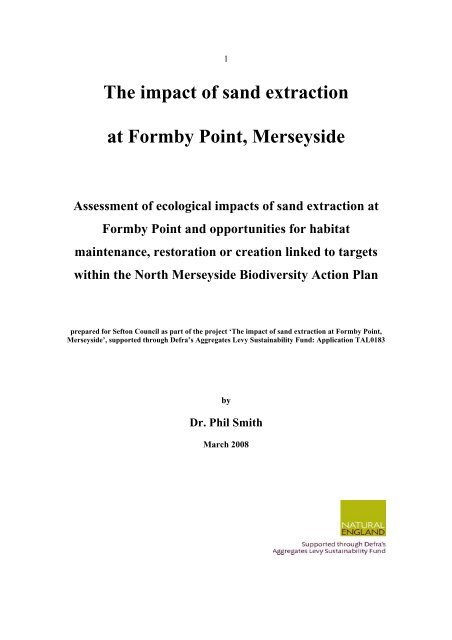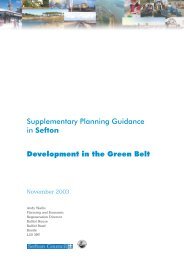The impact of sand extraction at Formby Point ... - Sefton Council
The impact of sand extraction at Formby Point ... - Sefton Council
The impact of sand extraction at Formby Point ... - Sefton Council
You also want an ePaper? Increase the reach of your titles
YUMPU automatically turns print PDFs into web optimized ePapers that Google loves.
1<br />
<strong>The</strong> <strong>impact</strong> <strong>of</strong> <strong>sand</strong> <strong>extraction</strong><br />
<strong>at</strong> <strong>Formby</strong> <strong>Point</strong>, Merseyside<br />
Assessment <strong>of</strong> ecological <strong>impact</strong>s <strong>of</strong> <strong>sand</strong> <strong>extraction</strong> <strong>at</strong><br />
<strong>Formby</strong> <strong>Point</strong> and opportunities for habit<strong>at</strong><br />
maintenance, restor<strong>at</strong>ion or cre<strong>at</strong>ion linked to targets<br />
within the North Merseyside Biodiversity Action Plan<br />
prepared for <strong>Sefton</strong> <strong>Council</strong> as part <strong>of</strong> the project ‘<strong>The</strong> <strong>impact</strong> <strong>of</strong> <strong>sand</strong> <strong>extraction</strong> <strong>at</strong> <strong>Formby</strong> <strong>Point</strong>,<br />
Merseyside’, supported through Defra’s Aggreg<strong>at</strong>es Levy Sustainability Fund: Applic<strong>at</strong>ion TAL0183<br />
by<br />
Dr. Phil Smith<br />
March 2008
2<br />
Assessment <strong>of</strong> ecological <strong>impact</strong>s <strong>of</strong> <strong>sand</strong> <strong>extraction</strong> <strong>at</strong> <strong>Formby</strong> <strong>Point</strong> and<br />
opportunities for habit<strong>at</strong> maintenance, restor<strong>at</strong>ion or cre<strong>at</strong>ion linked to targets<br />
within the North Merseyside Biodiversity Action Plan<br />
Philip H. Smith, March 2008<br />
1. Introduction<br />
<strong>Formby</strong> <strong>Point</strong> is part <strong>of</strong> the <strong>Sefton</strong> Coast <strong>sand</strong>-dune system, the largest area <strong>of</strong> coastal<br />
dunes in England. Reflecting its importance for wildlife, <strong>Formby</strong> <strong>Point</strong> is included in the<br />
<strong>Sefton</strong> Coast Site <strong>of</strong> Special Scientific Interest design<strong>at</strong>ed in 2000. <strong>The</strong> area also benefits<br />
from EU protection, being part <strong>of</strong> a Special Area <strong>of</strong> Conserv<strong>at</strong>ion and N<strong>at</strong>ura 2000 site.<br />
<strong>The</strong> dune system has been listed as a wetland <strong>of</strong> intern<strong>at</strong>ional importance under the<br />
Ramsar Convention and is also a Site <strong>of</strong> Local Biological Interest under the <strong>Sefton</strong><br />
Unitary Development Plan.<br />
<strong>The</strong> <strong>Sefton</strong> Coast <strong>sand</strong>-dunes have been subject to extensive modific<strong>at</strong>ion by a wide<br />
range <strong>of</strong> human activities (Smith 1999), one <strong>of</strong> these being large-scale removal <strong>of</strong> <strong>sand</strong><br />
for industrial purposes. From <strong>at</strong> least the 1920s or 1930s onwards, <strong>sand</strong>-winning took<br />
place from several sites <strong>at</strong> <strong>Formby</strong> <strong>Point</strong>, despite the fact th<strong>at</strong> the coastline had been<br />
subject to rapid marine erosion since about 1906. In the early years, the industry appears<br />
to have been unregul<strong>at</strong>ed but there are records <strong>of</strong> planning applic<strong>at</strong>ions for <strong>sand</strong><br />
<strong>extraction</strong> between 1949 and 1959, while a public inquiry took place in the 1960s. In<br />
1958, a Coast Protection Order was enacted by <strong>Formby</strong> Urban District <strong>Council</strong> and no<br />
further applic<strong>at</strong>ions were considered to the west <strong>of</strong> an arbitrary line, though <strong>sand</strong> removal<br />
continued to take place until 1970.<br />
This report was commissioned in September 2007, its aim being to investig<strong>at</strong>e the<br />
ecological <strong>impact</strong>s <strong>of</strong> <strong>sand</strong> <strong>extraction</strong> <strong>at</strong> <strong>Formby</strong> <strong>Point</strong>. <strong>The</strong> Project Brief requested the<br />
following:<br />
• Review relevant inform<strong>at</strong>ion held by the contractor and other sources, if appropri<strong>at</strong>e.<br />
• Assess the positive and neg<strong>at</strong>ive <strong>impact</strong>s <strong>of</strong> the industry.
• Rapid, up-to-d<strong>at</strong>e assessment <strong>of</strong> the condition <strong>of</strong> the habit<strong>at</strong>s and species associ<strong>at</strong>ed<br />
with former <strong>sand</strong> <strong>extraction</strong> sites, noting any positive and neg<strong>at</strong>ive trends.<br />
3<br />
• Advise on management <strong>of</strong> existing sites, with reference to the management plans for<br />
Lifebo<strong>at</strong> Road, Ravenmeols Local N<strong>at</strong>ure Reserve and Cabin Hill N<strong>at</strong>ional N<strong>at</strong>ure<br />
Reserve.<br />
• Assess potential for future habit<strong>at</strong> maintenance, restor<strong>at</strong>ion and cre<strong>at</strong>ion <strong>at</strong> several<br />
scales – from small-scale and local (e.g. single slack) to large-scale (e.g. restor<strong>at</strong>ion<br />
plan for whole <strong>extraction</strong> site).<br />
• Comment on potential for positive habit<strong>at</strong> management, restor<strong>at</strong>ion or cre<strong>at</strong>ion for<br />
BAP habit<strong>at</strong>s and species, including N<strong>at</strong>terjack Toad, Sand Lizard, Common Lizard,<br />
Gre<strong>at</strong> Crested Newt, Northern Dune Tiger Beetle, Colletes Vernal Mining Bee,<br />
Grayling, Dark Green Fritillary and others.<br />
2. Ecological survey<br />
2.2. Methods<br />
Loc<strong>at</strong>ions <strong>of</strong> major <strong>sand</strong> quarries <strong>at</strong> Lifebo<strong>at</strong> Road, Ravenmeols and Cabin Hill, as<br />
defined by recent Lidar survey and aerial photographs taken in 1945, 1961 and 1979,<br />
were visited in early October 2007. Notes were made on habit<strong>at</strong>s and veget<strong>at</strong>ion, with<br />
particular reference to habit<strong>at</strong>s scheduled in the EU Habit<strong>at</strong>s Directive and<br />
regionally/n<strong>at</strong>ionally notable species, including those considered in the North Merseyside<br />
BAP. Changes over time were determined by reference to aerial photographs, N<strong>at</strong>ional<br />
Veget<strong>at</strong>ion Classific<strong>at</strong>ion (NVC) reports and maps, other reports, personal note-books<br />
and transparencies. Site Management Plans were examined in the context <strong>of</strong> habit<strong>at</strong> and<br />
species management and potential for future habit<strong>at</strong> restor<strong>at</strong>ion/cre<strong>at</strong>ion.<br />
2.3. Results<br />
2.3.1. Lifebo<strong>at</strong> Road<br />
All <strong>of</strong> this area is owned by <strong>Sefton</strong> Metropolitan Borough <strong>Council</strong>. As determined from<br />
the 1945 photographs, the main quarry site is bounded by pine woodland in the east,<br />
Lifebo<strong>at</strong> Road to the south, Wicks Lane p<strong>at</strong>h in the north and former Asparagus fields to<br />
the west. It is also inferred th<strong>at</strong> <strong>sand</strong> removal took place from frontal dunes to the north
4<br />
<strong>of</strong> the disused Lifebo<strong>at</strong> St<strong>at</strong>ion. Much <strong>of</strong> the l<strong>at</strong>ter area has been lost to subsequent coast<br />
erosion and dune development. It may well be, however, th<strong>at</strong> the severe damage done by<br />
<strong>sand</strong>-winning began the process <strong>of</strong> frontal dune defl<strong>at</strong>ion which was exacerb<strong>at</strong>ed by<br />
public pressure in the 1960s. Thus, the defl<strong>at</strong>ion area north <strong>of</strong> Lifebo<strong>at</strong> Road shown in<br />
the 1961 and l<strong>at</strong>er photographs corresponds very closely to the 1945 <strong>sand</strong> quarry. Wind<br />
erosion seriously weakened the coast-protection function <strong>of</strong> the dunes, the area becoming<br />
a priority for dune restor<strong>at</strong>ion in the early years <strong>of</strong> the <strong>Sefton</strong> Coast Management Scheme<br />
(1978 to 1985). It was eventually stabilised after recontouring, planting with Marram<br />
(Ammophila arenaria) and formalis<strong>at</strong>ion <strong>of</strong> footp<strong>at</strong>h access (Smith 1999). Over 20 years<br />
on, this area is now a gentle west-facing slope <strong>of</strong> Rabbit-grazed, r<strong>at</strong>her impoverished,<br />
mossy, semi-fixed dune with sparse Marram.<br />
A series <strong>of</strong> small N<strong>at</strong>terjack Toad breeding pools has been maintained in the lowest-lying<br />
part <strong>of</strong> this area, just east <strong>of</strong> the coast fringe <strong>of</strong> mobile-dunes. <strong>The</strong>se <strong>at</strong>tracted large<br />
numbers <strong>of</strong> adults in the 1980s but the st<strong>at</strong>us <strong>of</strong> current popul<strong>at</strong>ion is not clear. <strong>The</strong>re is a<br />
considerable extent <strong>of</strong> suitable terrestrial habit<strong>at</strong> which should be capable <strong>of</strong> supporting a<br />
large number <strong>of</strong> toads. Successful breeding was recorded in 2006 (100s <strong>of</strong> toadlets) but<br />
there was no monitoring in 2005. Three extant scrapes (6, 7 & 8) are small and only one<br />
(no. 6) held w<strong>at</strong>er <strong>at</strong> the time <strong>of</strong> the survey. This is also the only scrape with an<br />
interesting flora, which includes the notable Grey Club-rush (Schoenoplectus<br />
tabernaemontani), Small-fruited Yellow-sedge (Carex viridula ssp. viridula), Brookweed<br />
(Samolus valerandi), Seaside Centaury (Centaurium littorale), Early Marsh-orchid<br />
(Dactylorhiza incarn<strong>at</strong>a) and Varieg<strong>at</strong>ed Horsetail (Equisetum varieg<strong>at</strong>um).<br />
Further east were originally situ<strong>at</strong>ed high dunes imposing enough to have been given the<br />
local names “Beacon Hill” and “Shorrock’s Hill”. <strong>The</strong>se were entirely removed, leaving<br />
a quarry, the eastern edge <strong>of</strong> which is a bluff about 10m high, once steep and <strong>sand</strong>y but<br />
now slumped to about 30 o and clothed with pine planted in 1983 and regener<strong>at</strong>ing poplar.<br />
<strong>The</strong> adjacent quarry floor was invaded by scrub from the l<strong>at</strong>e 1960s onwards and now<br />
supports a dense mixed woodland, especially <strong>of</strong> Grey Poplar (Populus x canescens),<br />
Aspen (P. tremula), Hybrid Black-poplar (P. x canadensis) and Balm-<strong>of</strong>-Gilead (P. x
5<br />
jackii) with a smaller component <strong>of</strong> Sycamore (Acer pseudopl<strong>at</strong>anus), oak (Quercus),<br />
birch (Betula) and Grey Alder (Alnus incana) and Corsican Pine (Pinus nigra ssp.<br />
laricio). Damper areas have been colonised by Grey Willow (Salix cinerea), Crack<br />
Willow (S. fragilis), Hybrid Crack-willow (S. x rubens) and Fine Osier (S. x forbyana),<br />
with much Creeping Willow (S. repens) in canopy gaps. Despite their rel<strong>at</strong>ively young<br />
ages, the trees have trunk diameters averaging 30-40cm, with a few up to 80cm. Bene<strong>at</strong>h<br />
the trees is a varied ground flora <strong>of</strong> grasses, herbs and ferns.<br />
In the 1960s and 1970s, the now wooded area contained a series <strong>of</strong> slacks which were<br />
mapped and described by Smith (1978a, 1978b). <strong>The</strong>y flooded deeply in 1968/69 and<br />
again in spring 1977, supporting large numbers <strong>of</strong> Common Toads (Bufo bufo). <strong>The</strong>y<br />
also had a diverse veget<strong>at</strong>ion, including such n<strong>at</strong>ionally/regionally notable plants as<br />
Small-fruited Yellow-sedge, Early Marsh-orchid, Marsh Helleborine (Epipactis<br />
palustris), Varieg<strong>at</strong>ed Horsetail, Grass-<strong>of</strong>-Parnassus (Parnassia palustris), Seaside<br />
Centaury, Brookweed and Fl<strong>at</strong>-sedge (Blysmus compressus). Unfortun<strong>at</strong>ely, some <strong>of</strong> the<br />
slacks were filled in during the construction <strong>of</strong> a new access track to the carpark in 1978<br />
(Smith 1978b). A relict <strong>of</strong> one slack, surrounded by scrub, survives <strong>at</strong> SD 27768 06645.<br />
This is now much dryer, is domin<strong>at</strong>ed by Creeping Willow and retains few wet-slack<br />
plants, such as Cuckoo-flower (Cardamine pr<strong>at</strong>ensis), Marsh Bedstraw (Galium palustre)<br />
and Shore Horsetail (Equisetum x litorale). Another small slack which once supported a<br />
fine stand <strong>of</strong> Fl<strong>at</strong>-sedge has long disappeared under scrub. Within the woodland, two<br />
narrow basins were deepened in about 1980 to form “newt scrapes”. <strong>The</strong>se are now<br />
r<strong>at</strong>her shaded and moss-domin<strong>at</strong>ed with a few relict wetland plants, such as Common<br />
Reed (Phragmites australis), Hard Rush (Juncus inflexus), Common Spike-rush<br />
(Eleocharis palustris), Lesser Spearwort (Ranunculus flammula) and W<strong>at</strong>er Mint<br />
(Mentha aqu<strong>at</strong>ica). <strong>The</strong> only notable plant is Brookweed. <strong>The</strong> southern scrape contains<br />
a little <strong>of</strong> the invasive alien New Zealand Pigmy-weed (Crassula helmsii).<br />
<strong>The</strong> edges <strong>of</strong> former slacks adjacent to the access track are now picked out by willows,<br />
which include three specimens <strong>of</strong> the n<strong>at</strong>ionally rare hybrid Salix x doniana, known from
6<br />
only six post-1987 10km squares (hectads) in the British Isles. Nearby, are two bushes <strong>of</strong><br />
Salix x friesiana (14 post-1987 hectads), also n<strong>at</strong>ionally rare.<br />
To the west <strong>of</strong> the m<strong>at</strong>ure woodland, a zone <strong>of</strong> regener<strong>at</strong>ing scrub, mainly Balm-<strong>of</strong>-<br />
Gilead much affected by fungal die-back, gradually gives way to a gently undul<strong>at</strong>ing<br />
landscape, the veget<strong>at</strong>ion <strong>of</strong> which consists <strong>of</strong> a mosaic <strong>of</strong> grassy fixed-dune and fixed<br />
dune with Creeping Willow with sc<strong>at</strong>tered small trees <strong>of</strong> birch and pine. <strong>The</strong>re is one<br />
fine young specimen <strong>of</strong> Salix x doniana <strong>at</strong> SD 27646 06693. <strong>The</strong> western edge <strong>of</strong> the<br />
quarry here is a 3-4m-high fixed dune ridge, beyond which lies the Lifebo<strong>at</strong> Road carpark<br />
on wh<strong>at</strong> were probably originally Asparagus fields.<br />
To the south, a square pine plant<strong>at</strong>ion on top <strong>of</strong> a 3-4m-high pl<strong>at</strong>eau survived <strong>sand</strong>winning.<br />
On its southern flank, next to Lifebo<strong>at</strong> Road, is a level area which was probably<br />
one <strong>of</strong> the first to be excav<strong>at</strong>ed for <strong>sand</strong>. This is now heavily Rabbit-grazed fixed-dune<br />
domin<strong>at</strong>ed by Red Fescue (Festuca rubra) and Common Bent (Agrostis capillaris) with a<br />
diversity <strong>of</strong> herbaceous plants, including Common Stork’s-bill (Erodium cicutarium), the<br />
n<strong>at</strong>ionally scarce Sticky Stork’s-bill (E. lebelii) and their rare hybrid Erodium x<br />
anarist<strong>at</strong>um, known only from coastal dunes in Wales and South Lancashire.<br />
Immedi<strong>at</strong>ely west <strong>of</strong> the pine block is a dune hollow, a blow-out in 1978, which was<br />
deepened to produce a N<strong>at</strong>terjack Toad scrape about 20m in diameter in the 1980s (no.<br />
10). This now contains a few slack plants, the only notable species being Small-fruited<br />
Yellow-sedge. It has not been used by N<strong>at</strong>terjacks for some time but, in wet years, has<br />
been known to support dragonflies.<br />
Moving north <strong>of</strong> the wooded part <strong>of</strong> the quarry is a low-lying, almost level area traversed<br />
by footp<strong>at</strong>hs. Its veget<strong>at</strong>ion consists <strong>of</strong> a mosaic <strong>of</strong> Grey Poplar scrub (some recently cut<br />
but re-sprouting), p<strong>at</strong>ches <strong>of</strong> Creeping Willow and acid fixed-dune grassland, domin<strong>at</strong>ed<br />
by Common Bent and Sand Sedge (Carex arenaria). <strong>The</strong> l<strong>at</strong>ter also supports the notable<br />
species Smooth C<strong>at</strong>’s-ear (Hypochaeris glabra) (Smith 2007a) and Sticky Stork’s-bill.<br />
Where pedestrian trampling has kept the turf short, there is heavy Rabbit grazing. This<br />
area slopes upwards to the north by about 1.5m to a near-level pl<strong>at</strong>eau <strong>of</strong> open, partially-
grazed, fixed-dune grassland characterised by Sand Sedge and Common Bent with<br />
frequent Dewberry (Rubus caesius), Rosebay Willowherb (Chamerion angustifolium)<br />
and Common Ragwort (Senecio jacobaea). Several formal and informal footp<strong>at</strong>hs cross<br />
the area. P<strong>at</strong>ches <strong>of</strong> taller veget<strong>at</strong>ion add to habit<strong>at</strong> diversity but this is restricted by the<br />
lack <strong>of</strong> a varied topography.<br />
7<br />
Further north, the land rises to fixed-dune ridges and then falls to Wicks Lake where I<br />
photographed <strong>sand</strong>-winning as recently as 1970. <strong>The</strong> lake was cre<strong>at</strong>ed in 1979 by<br />
deepening an existing basin-site formed by earlier <strong>sand</strong> <strong>extraction</strong>. For about ten years, it<br />
was used as a recre<strong>at</strong>ional facility but concerns about w<strong>at</strong>er-quality led to the wetland<br />
being fenced <strong>of</strong>f and managed as a n<strong>at</strong>ure conserv<strong>at</strong>ion site. <strong>The</strong> margins were planted<br />
with Alder (Alnus glutinosa) and a variety <strong>of</strong> willows, now up to 7m tall, while various<br />
wetland plants were introduced to produce a marginal reed-swamp <strong>of</strong> Bulrush (Typha<br />
l<strong>at</strong>ifolia), Common Reed, Grey Club-rush and Lesser Pond-sedge (Carex acutiformis).<br />
By the 1990s, the site was particularly noted for its dragonflies (Odon<strong>at</strong>a) and was<br />
fe<strong>at</strong>ured in the field guide by Brooks & Lewington (1997). However, in recent years, an<br />
increasing popul<strong>at</strong>ion <strong>of</strong> ducks fed by visitors has polluted the w<strong>at</strong>er and pred<strong>at</strong>ed aqu<strong>at</strong>ic<br />
life, leading to the almost complete elimin<strong>at</strong>ion <strong>of</strong> Odon<strong>at</strong>a. <strong>The</strong> western, shallower, arm<br />
<strong>of</strong> the lake has developed interesting slack-like, semi-aqu<strong>at</strong>ic veget<strong>at</strong>ion, including many<br />
marsh-orchids (Dactylorhiza), Brookweed, Cyperus Sedge (Carex pseudocyperus) and<br />
Brown Sedge (C. disticha). A single bush <strong>of</strong> Salix x friesiana was noted. However, this<br />
section is now being colonised by scrub, especially suckering Alder and Grey Willow,<br />
while an area <strong>of</strong> about 25m x 20m supports a dense popul<strong>at</strong>ion <strong>of</strong> the invasive New<br />
Zealand Pigmy-weed.<br />
To the west and south-west <strong>of</strong> Wicks Lake, the final section <strong>of</strong> the <strong>extraction</strong> zone<br />
consists partly <strong>of</strong> a large level <strong>of</strong> fixed-dune domin<strong>at</strong>ed by Red Fescue, Common Bent<br />
and Sand Sedge. This site, which has p<strong>at</strong>chy Rabbit grazing, was used as a football pitch<br />
in the early 1970s. It is deline<strong>at</strong>ed to the west by an old field boundary <strong>of</strong> wind-pruned<br />
poplar trees reinforced by pine planting in 1985. Adjoining it to the south are gently<br />
undul<strong>at</strong>ing fixed-dunes with occasional small blow-outs, one <strong>of</strong> which has been recently
8<br />
infilled and supports ruderal veget<strong>at</strong>ion <strong>of</strong> Common Ragwort, Evening-primrose<br />
(Oenothera) and Hound’s-tongue (Cynoglossum <strong>of</strong>ficinale). Otherwise, the area has a<br />
r<strong>at</strong>her mossy, open, Rabbit-grazed sward <strong>of</strong> acid grassland with a sc<strong>at</strong>tered popul<strong>at</strong>ion <strong>of</strong><br />
Smooth C<strong>at</strong>’s-ear.<br />
G<strong>at</strong>eley & Michell (2004) report trends <strong>at</strong> Lifebo<strong>at</strong> Road since the previous NVC survey<br />
in 1988/89. Thus, mixed scrub/woodland has spread over many areas <strong>of</strong> open dune and<br />
slack in the eastern and southern parts <strong>of</strong> the site, while former areas <strong>of</strong> open w<strong>at</strong>er and<br />
slack veget<strong>at</strong>ion are diminished. Even Wicks Lake was dry <strong>at</strong> the time <strong>of</strong> their field work<br />
in 2004.<br />
2.3.2. Ravenmeols LNR<br />
South <strong>of</strong> Lifebo<strong>at</strong> Road, a large area <strong>of</strong> Ravenmeols dunes, owned by <strong>Sefton</strong> <strong>Council</strong>, has<br />
also been subject to past <strong>sand</strong>-winning, the area affected being more readily determined<br />
by reference to Lidar mapping than to the 1945 and 1961 aerial photographs. On the<br />
ground, an obvious quarry edge can be seen where taller dunes rise to the west, north and<br />
south, the eastern boundary being much more difficult to determine, partly due to dense<br />
scrub colonis<strong>at</strong>ion.<br />
Smith (1980) conducted the first detailed ecological survey <strong>of</strong> this area, making reference<br />
to several wet-slacks which seemed to have origin<strong>at</strong>ed from <strong>sand</strong>-winning and also to<br />
areas <strong>of</strong> small hummocks, north <strong>of</strong> Alexandra Road, which probably represent<br />
overburden tipped in already extracted sites. It is also clear th<strong>at</strong> large quantities <strong>of</strong> <strong>sand</strong><br />
were removed from the frontal dunes, working in a south-easterly direction from the<br />
shore. Smith (1980) refers to a “blow-through” cutting though the main mobile-dune<br />
ridge about 250m south <strong>of</strong> Lifebo<strong>at</strong> Road, which evidently had been caused by <strong>sand</strong>winning.<br />
At the time <strong>of</strong> his survey, this fe<strong>at</strong>ure was 50m wide <strong>at</strong> its seaward end and<br />
blown <strong>sand</strong> was smothering the adjacent fixed-dunes. This blow-through was brushwood<br />
fenced and planted with Marram from 1979 under the auspices <strong>of</strong> the <strong>Sefton</strong> Coast<br />
Management Scheme.
9<br />
<strong>The</strong> veget<strong>at</strong>ion <strong>of</strong> the main quarry area was mapped and its (pre-NVC) communities<br />
described by Smith (1980). Twenty-seven years on, the area is essentially similar; a<br />
slightly undul<strong>at</strong>ing topography supports a mosaic <strong>of</strong> grassy fixed-dune on the higher<br />
ground and extensive areas <strong>of</strong> fixed-dune with Creeping Willow in the lower-lying areas.<br />
<strong>The</strong> l<strong>at</strong>ter community corresponds with the NVC’s SD16 (Salix repens – Holcus lan<strong>at</strong>us<br />
dune-slack) (dryer type) while the former is mapped as SD7 (Ammophila arenaria –<br />
Festuca rubra semi-fixed dune) by G<strong>at</strong>eley & Michell (2004). To the east, the Creeping<br />
Willow is frequently accompanied by Tuberous Pea (L<strong>at</strong>hyrus tuberosus), an <strong>at</strong>tractive<br />
alien which has been known here since the 1920s (Smith 1980). <strong>The</strong> n<strong>at</strong>ionally rare<br />
Dune Helleborine (Epipactis dunensis) occurs sparingly amongst the Creeping Willow<br />
but none was seen during this study.<br />
Especially to the north and east are sc<strong>at</strong>tered clumps <strong>of</strong> scrub, comprising mainly White<br />
Poplar (Populus alba), Sea Buckthorn (Hippophae rhamnoides), Grey Willow, Fine<br />
Osier, Balm <strong>of</strong> Gilead, birch and Hawthorn (Cr<strong>at</strong>aegus monogyna). <strong>The</strong> White Poplar<br />
and Sea Buckthorn clumps are suckering freely into adjacent habit<strong>at</strong>s. Several specimens<br />
<strong>of</strong> Salix x friesiana were recorded. Interestingly, <strong>at</strong> various points along the western and<br />
southern quarry boundaries there are large willow p<strong>at</strong>ches, domin<strong>at</strong>ed by Fine Osier and<br />
Grey Willow, but also including Osier (S. viminalis), Go<strong>at</strong> Willow (S. caprea) and S. x<br />
friesiana. <strong>The</strong>ir establishment may have been encouraged by percol<strong>at</strong>ion <strong>of</strong> w<strong>at</strong>er from<br />
the adjacent high dunes.<br />
Three wet-slacks were mapped by Smith (1978a); these together with three damp slacks<br />
were sampled by Smith (1980) using NVC methodology. <strong>The</strong>y flooded in 1977 and,<br />
especially deeply, in 1982 when N<strong>at</strong>terjack Toads bred successfully. In 1980, all these<br />
slacks had a diverse veget<strong>at</strong>ion, though most were domin<strong>at</strong>ed by Creeping Willow. This<br />
is still the case, although the slacks now appear to be dryer, as would be expected after 27<br />
years <strong>of</strong> sediment accumul<strong>at</strong>ion. <strong>The</strong> largest and richest was slack 1, described by Smith<br />
(1980) as having Creeping Willow around the edge, which soon gives way to a heavily<br />
Rabbit-grazed sward domin<strong>at</strong>ed by bryophytes together with a high diversity <strong>of</strong> lowgrowing<br />
vascular plants. As in 1980, a well-used informal footp<strong>at</strong>h runs the length <strong>of</strong> the
10<br />
slack. Its veget<strong>at</strong>ion is still species-rich, the most notable plants being Grass-<strong>of</strong>-<br />
Parnassus, Marsh Helleborine and Early Marsh-orchid. <strong>The</strong> central area, although now<br />
with more Creeping Willow, retains a short Rabbit-grazed sward with sedges but fewer<br />
bryophytes, indic<strong>at</strong>ing its dryer condition. A damp slack in the central part <strong>of</strong> the<br />
quarry, recorded in 1980, still supports a popul<strong>at</strong>ion <strong>of</strong> Marsh Helleborine and Grass-<strong>of</strong><br />
Parnassus within a 15cm-high sward <strong>of</strong> Creeping Willow. Nearby is a scrape dug in<br />
2000 when a p<strong>at</strong>ch <strong>of</strong> Sea Buckthorn was removed. Its floor is about 1.5m below the<br />
general dune surface and is quite wet, with a stand <strong>of</strong> Hard Rush together with good<br />
popul<strong>at</strong>ions <strong>of</strong> the notable slack plants Small-fruited Yellow-sedge, Grass-<strong>of</strong>-Parnassus,<br />
Marsh Helleborine, Seaside Centaury, Varieg<strong>at</strong>ed Horsetail and Knotted Pearlwort<br />
(Sagina nodosa). This veget<strong>at</strong>ion is currently maintained by heavy Rabbit-grazing.<br />
Immedi<strong>at</strong>ely west <strong>of</strong> the caravan site is another low-lying area which probably also arose<br />
from <strong>sand</strong>-winning and had breeding N<strong>at</strong>terjack Toads in 1982. It is domin<strong>at</strong>ed by<br />
Creeping Willow but now lacks the wet-slack plants, including orchids, which were<br />
recorded here in the 1980s. <strong>The</strong> final slack to be mentioned is one cre<strong>at</strong>ed by a 1980s<br />
scrape in the floor <strong>of</strong> a small blow-out on the southern edge <strong>of</strong> the quarry, near Alexandra<br />
Road. This is now veget<strong>at</strong>ed and supports an impressive popul<strong>at</strong>ion <strong>of</strong> marsh-orchids,<br />
together with Marsh Helleborine and Grass-<strong>of</strong>-Parnassus.<br />
To the south <strong>of</strong> slack 1, the area <strong>of</strong> hummocks described by Smith (1980) is now much<br />
less obvious. <strong>The</strong> topography has become obscured by surface erosion and by veget<strong>at</strong>ion<br />
changes. Previously domin<strong>at</strong>ed by bryophytes, the hummocks now mainly support<br />
Creeping Willow with occasional grassy p<strong>at</strong>ches.<br />
To the south <strong>of</strong> the main quarry area, in the vicinity <strong>of</strong> Alexandra Road and Albert Road,<br />
is a series <strong>of</strong> small <strong>sand</strong> <strong>extraction</strong> areas identified from aerial photographs and Lidar<br />
survey. <strong>The</strong>se are partly covered in dune-scrub and were not investig<strong>at</strong>ed in detail.<br />
As to the north <strong>of</strong> Lifebo<strong>at</strong> Road, <strong>sand</strong>-winning in the Ravenmeols frontal-dunes has<br />
largely been obscured by l<strong>at</strong>er marine erosion and <strong>sand</strong>-blow. Some <strong>of</strong> the highest dunes
11<br />
on the <strong>Sefton</strong> Coast occur here but there is a lower-lying area, surrounded by Marramdomin<strong>at</strong>ed<br />
dune ridges, which is probably a relict <strong>of</strong> earlier <strong>sand</strong> removal. One blow-out<br />
in this area has eroded down to the w<strong>at</strong>er-table but not sufficiently, as yet, to form a<br />
slack. <strong>The</strong>re is a large area <strong>of</strong> prime N<strong>at</strong>terjack Toad habit<strong>at</strong> here but, unfortun<strong>at</strong>ely,<br />
nowhere for the cre<strong>at</strong>ure to breed. To the east <strong>of</strong> the highest ridge, is a dune valley which<br />
probably origin<strong>at</strong>ed from <strong>sand</strong>-winning. Clothed by Creeping Willow and Marram, it<br />
contains a scrape dug in 1987. Due to <strong>sand</strong>-accumul<strong>at</strong>ion, this is now rel<strong>at</strong>ively dry,<br />
containing only a little Marsh Pennywort (Hydrocotyle vulgaris) to indic<strong>at</strong>e the proximity<br />
<strong>of</strong> the w<strong>at</strong>er-table.<br />
Ravenmeols was surveyed in 1988/89 and 2003 for the <strong>Sefton</strong> Coast NVC. G<strong>at</strong>eley &<br />
Michell (2004) report th<strong>at</strong> fixed-dune communities became simplified with a gre<strong>at</strong>er<br />
proportion being recorded as SD7. Meanwhile, the areas <strong>of</strong> damp-slack decreased and<br />
the dry SD16 community, domin<strong>at</strong>ed by Creeping Willow, became more extensive.<br />
<strong>The</strong>ir findings support the observ<strong>at</strong>ions made during the current study.<br />
2.3.3. Cabin Hill<br />
Cabin Hill contains two extensive <strong>sand</strong>-winning areas, the most obvious one <strong>at</strong> the end <strong>of</strong><br />
Range Lane, in the ownership <strong>of</strong> <strong>Sefton</strong> <strong>Council</strong>, covers about 4.5ha and is well<br />
demarc<strong>at</strong>ed on three sides by cliffed dunes. <strong>The</strong> marks <strong>of</strong> heavy machinery are<br />
particularly well shown on the 1961 aerial photograph. <strong>The</strong> other, larger, site is less well<br />
defined both on aerial photographs and on the ground and covers part <strong>of</strong> the 28.4ha Cabin<br />
Hill N<strong>at</strong>ional N<strong>at</strong>ure Reserve leased in 1985 by the N<strong>at</strong>ure Conservancy <strong>Council</strong> (now<br />
N<strong>at</strong>ural England) and declared in 1991. <strong>The</strong> name <strong>of</strong> this area refers to the largest <strong>sand</strong>dune<br />
and landmark on this part <strong>of</strong> the coast which was completely removed, in places<br />
down to the w<strong>at</strong>er-table. This so weakened the coast protection function <strong>of</strong> the dune belt<br />
th<strong>at</strong> the then Mersey & Weaver River Authority constructed a flood defence barrier bank<br />
about 750m long in 1970/71, <strong>at</strong> gre<strong>at</strong> public expense. To build the bank, <strong>sand</strong> was<br />
excav<strong>at</strong>ed from a series <strong>of</strong> linear borrow-pits, cre<strong>at</strong>ing wetlands which, from about 1976<br />
to 1988 became the most important N<strong>at</strong>terjack Toad breeding site on the <strong>Sefton</strong> Coast,<br />
250 spawn strings being counted in spring 1978 (Smith 1978c). In the l<strong>at</strong>e 1970s, the
12<br />
popul<strong>at</strong>ion in slack 1 was considered to be the largest using a single w<strong>at</strong>er body in Britain<br />
(English N<strong>at</strong>ure 2004). During this period, the site also supported breeding Snipe,<br />
Lapwing and Moorhen and probably Sedge Warbler and Redshank. Passage birds<br />
included Spoonbill, Osprey, Temminck’s Stint, Black Terns, Little Gulls, Lapland<br />
Bunting and the first British Eleonora’s Falcon in August 1977 (Smith 1978c). <strong>The</strong>se<br />
interests, and also thre<strong>at</strong>s from a proposed golf course development, were major reasons<br />
for the establishment <strong>of</strong> the NNR. In 1983, 206 and in 1988, 219 N<strong>at</strong>terjack spawn<br />
strings were counted <strong>at</strong> Cabin Hill but, during 1990s, m<strong>at</strong>ur<strong>at</strong>ion <strong>of</strong> the habit<strong>at</strong>s and<br />
invasion <strong>of</strong> the wetlands by an enormous popul<strong>at</strong>ion <strong>of</strong> Common Toads led to a severe<br />
decline in the rarer species here, only 19 strings being found in 2003 (English N<strong>at</strong>ure<br />
2004). Various management initi<strong>at</strong>ives, including the introduction <strong>of</strong> extensive winter<br />
sheep-grazing, have not, as yet, reversed this trend.<br />
<strong>The</strong> northern quarry <strong>at</strong> Cabin Hill has a slightly undul<strong>at</strong>ing floor, most <strong>of</strong> which is<br />
occupied by semi-fixed-dune veget<strong>at</strong>ion domin<strong>at</strong>ed by Marram, Red Fescue and Sand<br />
Sedge with frequent Dewberry and Common Ragwort. <strong>The</strong>re is also an abundance <strong>of</strong><br />
mosses and bare p<strong>at</strong>ches encouraged by heavy Rabbit-grazing. In the north-central area<br />
is a large scrape excav<strong>at</strong>ed in 1987, 3-4m below the general surface. At the time <strong>of</strong> the<br />
survey, this held shallow w<strong>at</strong>er (15cm deep). <strong>The</strong>re is a large stand <strong>of</strong> the regionally<br />
notable Grey Club-rush <strong>at</strong> the western end and Stoneworts (Charophytes) occur in the<br />
w<strong>at</strong>er. <strong>The</strong> dryer margins have a species-rich, Rabbit-grazed turf <strong>of</strong> sedges and other<br />
herbaceous plants, including Glaucous Sedge (Carex flacca), Small-fruited Yellowsedge,<br />
Grass-<strong>of</strong>-Parnassus, Marsh Helleborine, Bog Pimpernel (Anagallis tenella),<br />
Square-stalked St John’s-wort (Hypericum tetrapterum) and Selfheal (Prunella vulgaris).<br />
<strong>The</strong> site is also rich in bryophytes.<br />
<strong>The</strong> eastern part <strong>of</strong> the quarry has three sizeable damp slacks which probably d<strong>at</strong>e back to<br />
the earliest phase <strong>of</strong> <strong>sand</strong>-winning here. All have an east/west orient<strong>at</strong>ion and are<br />
domin<strong>at</strong>ed by Creeping Willow. <strong>The</strong>re is an increasing trend <strong>of</strong> wetness and <strong>of</strong> botanical<br />
richness from north to south. <strong>The</strong> northern, driest, slack has a few spikes <strong>of</strong> Marsh<br />
Helleborine, a single, r<strong>at</strong>her moribund, bush <strong>of</strong> Salix x friesiana, and a little Round-
leaved Wintergreen (Pyrola rotundifolia ssp. maritima). <strong>The</strong> middle basin supports<br />
Marsh Helleborine and also marsh-orchids, while the southernmost basin has these in<br />
abundance and other slack plants such as Marsh Pennywort, sedges, Yellow-wort<br />
(Blackstonia perfoli<strong>at</strong>a) and Silverweed (Potentilla anserina). <strong>The</strong> southern slack is<br />
flanked to the east by a large suckering clump <strong>of</strong> Sea Buckthorn. <strong>The</strong>se slacks were<br />
briefly described 28 years ago by Smith (1979) when they supported very similar<br />
veget<strong>at</strong>ion.<br />
13<br />
Once part <strong>of</strong> the quarry edge, the south-facing slope immedi<strong>at</strong>ely north <strong>of</strong> these slacks<br />
has a p<strong>at</strong>chy sward <strong>of</strong> Marram with plenty <strong>of</strong> bare <strong>sand</strong> p<strong>at</strong>ches produced by Rabbits. A<br />
juvenile Sand Lizard was photographed here on the r<strong>at</strong>her l<strong>at</strong>e d<strong>at</strong>e <strong>of</strong> 21 st October 2007.<br />
<strong>The</strong> higher, more mobile, ridges on the southern flank <strong>of</strong> Devil’s Hole have dense stands<br />
<strong>of</strong> Marram which are suitable for adult Sand Lizards during the breeding season while the<br />
lower south-facing slopes, with more open veget<strong>at</strong>ion, are ideal for adults l<strong>at</strong>er in the year<br />
and for juveniles (D. Hardaker pers. com.). Some small, suckering stands <strong>of</strong> Balm-<strong>of</strong>-<br />
Gilead and Fine Osier in this area may require controlling where they impinge on prime<br />
Sand Lizard habit<strong>at</strong>.<br />
To the east is a region <strong>of</strong> undul<strong>at</strong>ing terrain with much Creeping Willow and also stands<br />
<strong>of</strong> larger willows, including Fine Osier, Grey Willow, Go<strong>at</strong> Willow, Osier and Silkyleaved<br />
Osier (Salix x smithiana). One small hollow contains nine bushes <strong>of</strong> put<strong>at</strong>ive<br />
Salix x friesiana, though some may be referable to the even rarer Salix x angusensis (ten<br />
post-1987 British hectads). <strong>The</strong> l<strong>at</strong>ter taxon is extremely difficult to identify. Another<br />
nine specimens <strong>of</strong> S. x friesiana are associ<strong>at</strong>ed with a line <strong>of</strong> willow bushes th<strong>at</strong> form part<br />
<strong>of</strong> the probable eastern boundary <strong>of</strong> the <strong>sand</strong> quarry.<br />
<strong>The</strong> northern quarry <strong>at</strong> Cabin Hill is separ<strong>at</strong>ed by a semi-fixed-dune ridge about 4-5m<br />
high from the larger southern <strong>extraction</strong> area, within the NNR, which extends south to the<br />
Altcar Rifle Range boundary and beyond. <strong>The</strong> western section is mainly fixed or semifixed<br />
dune, domin<strong>at</strong>ed by Marram, sloping gradually upwards to the higher ridges which<br />
survived quarrying and have been reinforced by over 100m <strong>of</strong> new dune form<strong>at</strong>ion since
14<br />
1961. <strong>The</strong> 1945 aerial photo shows th<strong>at</strong> <strong>sand</strong>-winning invaded this area but evidence on<br />
the ground has been obscured by l<strong>at</strong>er accretion. About 100m north <strong>of</strong> the Rifle Range<br />
boundary is an enclave <strong>of</strong> lower-lying land extending about 100m westwards and<br />
probably representing an old <strong>extraction</strong> site. Except for some low semi-fixed, ridges, this<br />
area is now largely covered with Creeping Willow. One deeper basin (slack 28) was<br />
excav<strong>at</strong>ed as a small N<strong>at</strong>terjack Toad scrape in 1988 and repr<strong>of</strong>iled in 2005. <strong>The</strong><br />
shallow central area has been colonised by Common Spike-rush (Eleocharis palustris)<br />
and W<strong>at</strong>er Horsetail (Equisetum fluvi<strong>at</strong>ile), while the dryer surrounds support a rich plant<br />
community, including Small-fruited Yellow-sedge, marsh orchids, Grass-<strong>of</strong>-Parnassus,<br />
Seaside Centaury, Knotted Pearlwort, etc. Another, larger, slack basin to the south (slack<br />
26) is mostly domin<strong>at</strong>ed by tall Creeping Willow but, around the margins, it has Marsh<br />
Helleborine, marsh-orchids and the n<strong>at</strong>ionally scarce Round-leaved Wintergreen, the<br />
l<strong>at</strong>ter in some abundance.<br />
To the east is a large enclosure winter-grazed by Herdwick sheep and year-round by<br />
Rabbits. Most <strong>of</strong> this plot has a more-or-less level topography with extensive Creeping<br />
Willow. Slightly higher ground supports a sward <strong>of</strong> Red Fescue and Marram with much<br />
Dewberry. Small, sc<strong>at</strong>tered, bare p<strong>at</strong>ches are associ<strong>at</strong>ed with Rabbit activity but sheep<br />
do not seem to have had much effect on the substr<strong>at</strong>e. <strong>The</strong> Dune Helleborine has been<br />
recorded as “local” on fixed-dunes within the reserve (English N<strong>at</strong>ure 2004) but was not<br />
observed during my visits. <strong>The</strong>re is a sc<strong>at</strong>tering <strong>of</strong> larger willows, mainly Grey Willow,<br />
but also many bushes <strong>of</strong> Salix x friesiana and one or two th<strong>at</strong> may be S. x angusensis. A<br />
small plot, fenced to exclude livestock, is heavily colonised by large willows. <strong>The</strong><br />
frequency <strong>of</strong> willow bushes increases near to the main borrow-pit, this being one <strong>of</strong> the<br />
gre<strong>at</strong>est concentr<strong>at</strong>ions on the <strong>Sefton</strong> coast <strong>of</strong> rare willow hybrids, including about 50<br />
bushes <strong>of</strong> Salix x friesiana. Adjacent to the borrow-pit are two large (c. 1ha) wet-slack<br />
basins, numbered 2 and 20 by Smith (1978a). No. 20 supports an important popul<strong>at</strong>ion <strong>of</strong><br />
Fl<strong>at</strong>-sedge and a number <strong>of</strong> willows, including a single Purple Willow (S. purpurea), one<br />
bush <strong>of</strong> S. x doniana, 18 <strong>of</strong> S. x friesiana and also a Bay Willow (S. pentandra) which,<br />
although not notable, is rare in the dunes.
15<br />
Slack 2 was progressively invaded by mainly Grey Willow over a thirty year period, until<br />
2005 when site managers removed all but the rare hybrid willows, there being now eight<br />
S. x friesiana bushes and, nearby, one <strong>of</strong> the n<strong>at</strong>ionally scarce Salix x subsericea (16<br />
post-1987 hectads in the British Isles). Follow-up surveys (Smith 2007b) showed th<strong>at</strong> the<br />
cleared slack was colonised by 139 vascular plants, 28 being new to the NNR and 11<br />
regionally/n<strong>at</strong>ionally notable.<br />
<strong>The</strong> western borrow-pit (slack 1), being wetter than the adjacent dunes and slacks, has<br />
large areas <strong>of</strong> semi-aqu<strong>at</strong>ic veget<strong>at</strong>ion, including stands <strong>of</strong> Common Reed (Phragmites<br />
australis), Sea Club-rush (Bolboschoenus maritimus), Blunt-flowered Rush (Juncus<br />
subnodulosus) and W<strong>at</strong>er Horsetail with some Shore Horsetail. Dryer fringes are rich in<br />
slack plants such as Marsh Helleborine, marsh-orchids, Yellow Bartsia (Parentucellia<br />
viscosa) (regionally notable) and Grass-<strong>of</strong>-Parnassus. In the dryer, eastern borrow-pit<br />
(slack 3), the l<strong>at</strong>ter species achieves arguably its gre<strong>at</strong>est abundance in the entire dune<br />
system, assisted by heavy Rabbit-grazing which reduces competition from taller-growing<br />
plants.<br />
Slack 1 has been repr<strong>of</strong>iled several times since its form<strong>at</strong>ion in <strong>at</strong>tempts to improve its<br />
value as a N<strong>at</strong>terjack Toad breeding site. Most recently, in 2006, a central section was<br />
lined with fresh <strong>sand</strong>. This was used for spawning by a few N<strong>at</strong>terjacks but also,<br />
unfortun<strong>at</strong>ely, by large numbers <strong>of</strong> Common Toads.<br />
This borrow-pit is also deep enough to support Odon<strong>at</strong>a in some years, species recorded<br />
here including Emerald Damselfly (Lestes sponsa), Emperor (Anax imper<strong>at</strong>or), Migrant<br />
Hawker (Aeshna mixta) and Common Darter (Sympetrum striol<strong>at</strong>um).<br />
3. Ecological <strong>impact</strong> <strong>of</strong> <strong>sand</strong>-winning: positive and neg<strong>at</strong>ive trends<br />
Because detailed records were not kept before about 1970, it is now difficult to assess the<br />
ecological <strong>impact</strong> <strong>of</strong> <strong>sand</strong>-winning. Clearly, when it first took place there must have been<br />
c<strong>at</strong>astrophic disruption to ecosystems, including loss <strong>of</strong> habit<strong>at</strong>, local species extinctions<br />
and destruction <strong>of</strong> soils and seed-banks. Increased <strong>sand</strong>-blow may also have affected
16<br />
adjacent habit<strong>at</strong>s for a time. However, <strong>sand</strong>-dune ecosystems are known to recover quite<br />
quickly from major disturbances, a proportion <strong>of</strong> their characteristic biota being adapted<br />
to unstable conditions, including rapid colonising ability. <strong>The</strong> fact th<strong>at</strong> large areas <strong>of</strong><br />
undisturbed habit<strong>at</strong> remained between <strong>sand</strong>-quarries would have helped this process.<br />
N<strong>at</strong>terjack Toads, for example, may well have thrived in the open <strong>sand</strong>y conditions which<br />
followed <strong>sand</strong> <strong>extraction</strong> and which would have included abundant shallow pools in the<br />
quarry floors.<br />
<strong>The</strong>re are circumstances in which large-scale disturbance to <strong>sand</strong>-dunes may be<br />
positively beneficial to wildlife. Thus, most larger dune systems in Britain, including the<br />
<strong>Sefton</strong> Coast, are over-stabilised due to lack <strong>of</strong> grazing, the introduction <strong>of</strong> non-n<strong>at</strong>ive<br />
trees and shrubs and a recent preoccup<strong>at</strong>ion <strong>of</strong> land-managers with preventing <strong>sand</strong>-blow<br />
(Houston 1997). This encourages over-represent<strong>at</strong>ion <strong>of</strong> m<strong>at</strong>ure successional stages with<br />
consequent thre<strong>at</strong> to the many species th<strong>at</strong> require younger, more open, habit<strong>at</strong>s. Thus, it<br />
could be argued th<strong>at</strong> <strong>sand</strong>-winning <strong>at</strong> <strong>Formby</strong> <strong>Point</strong> reversed, for a time, the trend<br />
towards more stable conditions and provided opportunities for the plants and animals <strong>of</strong><br />
open dunes. However, the validity <strong>of</strong> this argument is reduced by the fact th<strong>at</strong>, <strong>at</strong> the<br />
time when most <strong>sand</strong>-winning took place, the dune veget<strong>at</strong>ion was more open and <strong>sand</strong>y<br />
than it has been in recent decades.<br />
While the <strong>sand</strong> quarries represent younger landscapes than would have been the case,<br />
they show plenty <strong>of</strong> evidence <strong>of</strong> having aged markedly since their cre<strong>at</strong>ion. Thus, the<br />
eastern section <strong>of</strong> the Lifebo<strong>at</strong> Road quarry has become heavily wooded over the past 30<br />
to 40 years, and trees and shrubs, many <strong>of</strong> which are non-n<strong>at</strong>ive, are still spreading. Tall<br />
Creeping Willow, almost all <strong>of</strong> the coastal variety argentea, has overgrown the lowerlying<br />
parts <strong>of</strong> Ravenmeols and Cabin Hill, while larger willows have invaded some <strong>of</strong> the<br />
wetter basin sites. Several slacks, which were formed when excav<strong>at</strong>ion breached the<br />
w<strong>at</strong>er-table, have become dryer, probably due to increased evapotranspir<strong>at</strong>ion and<br />
accumul<strong>at</strong>ion <strong>of</strong> sediment. Not all these trends are wholly deleterious however. For<br />
example “fixed dune with Creeping Willow”, which is so extensive on quarry floors, is<br />
listed for conserv<strong>at</strong>ion under Annex 1 <strong>of</strong> the EU Habit<strong>at</strong>s Directive. <strong>The</strong> larger willows
are <strong>of</strong>ten accompanied by n<strong>at</strong>ionally rare hybrids and dune scrub is known to be<br />
important for breeding birds and invertebr<strong>at</strong>es (Smith 1999).<br />
17<br />
Although we do not know whether important slacks were lost to <strong>sand</strong>-winning, the<br />
extracted landscape is nearer the w<strong>at</strong>er-table and therefore <strong>of</strong>ten wetter than might have<br />
been the case previously. Indeed, Smith (1978a) points out th<strong>at</strong> n<strong>at</strong>ural wet-slacks <strong>at</strong><br />
<strong>Formby</strong> <strong>Point</strong> were probably infilled for Asparagus cultiv<strong>at</strong>ion during an earlier period.<br />
As is well-known, many <strong>of</strong> the <strong>Sefton</strong> Coast’s most charism<strong>at</strong>ic species are associ<strong>at</strong>ed<br />
with wet-slacks (Smith 1999)<br />
<strong>The</strong> topography <strong>of</strong> extracted sites is <strong>of</strong>ten less varied than before, several large dunes,<br />
such as Beacon Hill, Shorrock’s Hill and Cabin Hill having been removed. Undul<strong>at</strong>ing<br />
dune topography, notably lacking in most <strong>sand</strong>-quarries, is highly beneficial to<br />
biodiversity by cre<strong>at</strong>ing a wide range <strong>of</strong> different micro-clim<strong>at</strong>es and habit<strong>at</strong>s. For<br />
example, the plant communities on north-facing slopes <strong>of</strong> fixed dunes differ from those<br />
on south-facing slopes (Smith 1999). It can be inferred th<strong>at</strong> animals are also influenced<br />
by such differences; for example the Northern Dune Tiger Beetle (Cicindela hybrida) is<br />
largely confined to localities with a southern exposure (Judd 2003), while Sand Lizards<br />
are also known to favour a southerly aspect.<br />
4. Potential for habit<strong>at</strong> maintenance, restor<strong>at</strong>ion or cre<strong>at</strong>ion<br />
4.1. Smaller-scale<br />
Large parts <strong>of</strong> the three main sites are already subject to formal Management Plans<br />
(<strong>Sefton</strong> Coast Life Project 1996; English N<strong>at</strong>ure 2004), which provide prescriptions for<br />
habit<strong>at</strong> and species management within areas previously extracted for <strong>sand</strong>. Th<strong>at</strong> for<br />
Cabin Hill NNR is especially detailed. It recommends, for example, reintroduction <strong>of</strong><br />
summer grazing, including trials <strong>of</strong> ponies, to supplement winter sheep grazing, accepting<br />
th<strong>at</strong> the current regime has been successful in controlling birch but not willow. Summer<br />
grazing was originally thought to be deleterious to N<strong>at</strong>terjacks through trampling and<br />
nutrient enrichment but these are no longer considered to be problems. Larger livestock<br />
should help to cre<strong>at</strong>e more bare p<strong>at</strong>ches. Another suggestion is to encourage Rabbit-
18<br />
grazing <strong>of</strong> Creeping Willow by mowing p<strong>at</strong>ches <strong>of</strong> the plant adjacent to warrens and<br />
already grazed areas. Additional warrens might be cre<strong>at</strong>ed by forming <strong>sand</strong> mounds in<br />
places th<strong>at</strong> are too wet for them <strong>at</strong> present.<br />
It is also proposed to remove all scrub over 1.5m high in the grazing enclosure and<br />
stump-tre<strong>at</strong>, apart from the rare hybrids. As described earlier, in 2005 this was done in<br />
slack 2, with beneficial results for biodiversity.<br />
Two small N<strong>at</strong>terjack scrapes (27 and 29) are proposed to be repr<strong>of</strong>iled and two new ones<br />
excav<strong>at</strong>ed in the mobile dunes. One each <strong>of</strong> these was completed in 2005 but their use by<br />
the toads has been poor. A particular problem <strong>at</strong> Cabin Hill may be th<strong>at</strong> the dunes are<br />
now so stable and heavily veget<strong>at</strong>ed th<strong>at</strong> the terrestrial habit<strong>at</strong> is becoming unsuitable for<br />
adult N<strong>at</strong>terjacks which are known to require a very open veget<strong>at</strong>ion structure for<br />
successful foraging.<br />
<strong>The</strong> Ravenmeols and Lifebo<strong>at</strong> Road Management Plan proposes various actions to<br />
control succession and enhance n<strong>at</strong>ure conserv<strong>at</strong>ion interest, including in areas <strong>of</strong> former<br />
<strong>sand</strong> quarrying. For example, the feasibility <strong>of</strong> livestock grazing <strong>at</strong> Ravenmeols is to be<br />
examined. Also, Rabbit-grazing could be encouraged by mowing areas beyond the p<strong>at</strong>hs<br />
and main warrens. Turf-stripping should be considered, especially in slacks, to remove<br />
nutrients and encourage early successional communities. <strong>The</strong> presence <strong>of</strong> several p<strong>at</strong>ches<br />
<strong>of</strong> Sea Buckthorn is mentioned; these are said to be <strong>at</strong>tractive to birds and should be<br />
maintained <strong>at</strong> their present extent but prevented from invading slacks. <strong>The</strong> wider value<br />
<strong>of</strong> dune-scrub to birds is acknowledged and the fact th<strong>at</strong> this could be improved by<br />
rot<strong>at</strong>ional coppicing to cre<strong>at</strong>e glades and open p<strong>at</strong>ches. Overall, it is recommended th<strong>at</strong><br />
scrub cover should be reduced to less than 5% <strong>of</strong> the area, with removal especially in and<br />
around slacks and Sand Lizard colonies. Three introduction sites for captive-bred Sand<br />
Lizards are mentioned. Six releases, totalling 189 individuals, took place between 1983<br />
and 1989 but it is st<strong>at</strong>ed th<strong>at</strong> the success <strong>of</strong> this oper<strong>at</strong>ion is unknown. This area is to be<br />
intensively studied by the North Merseyside Amphibian & Reptile Group in 2008 (D.<br />
Hardaker pers. com.). <strong>The</strong> problem <strong>of</strong> gradual infilling <strong>of</strong> N<strong>at</strong>terjack Toad breeding sites
19<br />
by blown <strong>sand</strong> is mentioned; these will require occasional repr<strong>of</strong>iling. <strong>The</strong> Plan also<br />
recommends the maintenance <strong>of</strong> “key pools” for N<strong>at</strong>terjacks <strong>at</strong> str<strong>at</strong>egic points along the<br />
coast.<br />
<strong>The</strong> present study shows th<strong>at</strong> the excav<strong>at</strong>ion <strong>of</strong> scrapes which breach the seasonal w<strong>at</strong>ertable<br />
can provide marked biodiversity improvements, particularly in respect <strong>of</strong> the humid<br />
dune-slack habit<strong>at</strong> and associ<strong>at</strong>ed notable plant species. Where terrestrial habit<strong>at</strong> is<br />
suitable, such scrapes have also been shown to provide vital spawning sites for the<br />
N<strong>at</strong>terjack Toad in landscape where this species would otherwise be unable to breed.<br />
4.2. Larger-scale<br />
<strong>The</strong> Ravenmeols and Lifebo<strong>at</strong> Road Management Plan advoc<strong>at</strong>es a feasibility study into<br />
repr<strong>of</strong>iling the <strong>sand</strong>-winning area in the southern part <strong>of</strong> Ravenmeols (i.e. <strong>at</strong> the western<br />
end <strong>of</strong> Range Lane) to improve the habit<strong>at</strong> for N<strong>at</strong>terjacks and Sand Lizards through the<br />
provision <strong>of</strong> mobile-dune and slacks. It makes no mention <strong>of</strong> the potential for similar<br />
works <strong>at</strong> Lifebo<strong>at</strong> Road.<br />
5. Potential for positive habit<strong>at</strong> management for BAP habit<strong>at</strong>s and species<br />
<strong>The</strong> following North Merseyside BAP habit<strong>at</strong>s and species are well represented in the<br />
<strong>sand</strong>-winning areas:<br />
HAPs: Sand Dunes.<br />
SAPs: N<strong>at</strong>terjack Toad, Sand Lizard, Dune Helleborine; Common Lizard, Northern<br />
Dune Tiger Beetle, Vernal Colletes Bee, Grayling, Dragonflies, Stoneworts, <strong>Sefton</strong> Coast<br />
Rare and Scarce Plants (hybrid willows).<br />
Burkmar (2006) has summarised North Merseyside BAP progress during the first five<br />
years <strong>of</strong> the Plan. As regards <strong>sand</strong>-dunes, the report emphasis the findings <strong>of</strong> G<strong>at</strong>eley &<br />
Michell (2004) and others th<strong>at</strong> the <strong>Sefton</strong> Coast dune system continues to be overstabilised<br />
with neutral grassland expanding in areas where fixed-dune or dry-slack<br />
veget<strong>at</strong>ion might be expected. An important factor may well be aerial deposition <strong>of</strong>
nitrogen, inputs lying within the critical load range <strong>of</strong> 10-20kg/ha/annum. Required<br />
management responses include turf-stripping, grazing and re-mobilis<strong>at</strong>ion <strong>of</strong> dunes.<br />
20<br />
Such management will also benefit most <strong>of</strong> the BAP species listed above. N<strong>at</strong>terjacks<br />
have faired reasonably well in the dune system as a whole but not <strong>at</strong> <strong>Formby</strong> <strong>Point</strong> where<br />
adverse competition with Common Toads and possible deterior<strong>at</strong>ion <strong>of</strong> terrestrial habit<strong>at</strong><br />
have resulted in declines. Good progress has been made against all SAP targets for Sand<br />
Lizard and, perhaps in part due to past under-recording, the species is now thought to<br />
occur in much higher numbers than was previously realised. Similarly, the Common<br />
Lizard seems to be thriving in suitable places on the dunes. Recent warmer summers<br />
may have been influential in the success <strong>of</strong> these two species and also dragonflies. <strong>The</strong><br />
<strong>Sefton</strong> Coast dune system is a key breeding area for these insects. However, the presence<br />
<strong>of</strong> their pred<strong>at</strong>ory aqu<strong>at</strong>ic larvae is undoubtedly deleterious to N<strong>at</strong>terjack Toad tadpoles<br />
and it is important th<strong>at</strong> pools used by the l<strong>at</strong>ter species are shallow enough to dry up in<br />
l<strong>at</strong>e summer, thereby elimin<strong>at</strong>ing pred<strong>at</strong>ors. Unpolluted duneland pools with a high<br />
calcium content are a key habit<strong>at</strong> for stoneworts, for which there is a need for a<br />
comprehensive survey <strong>of</strong> distribution and st<strong>at</strong>us.<br />
<strong>The</strong> Northern Dune Tiger Beetle (Cicindela hybrida), Vernal Colletes Bee (Colletes<br />
cunicularius ssp. celticus) and Grayling butterfly (Hipparchia semele) require semi-fixed<br />
or mobile dunes with sparse veget<strong>at</strong>ion and bare p<strong>at</strong>ches. All three have been the subject<br />
<strong>of</strong> recent ecological studies on the <strong>Sefton</strong> Coast. Thus, Judd (2003) cites 24 records <strong>of</strong><br />
the Tiger Beetle <strong>at</strong> Lifebo<strong>at</strong> Road/Ravenmeols and eight <strong>at</strong> Cabin Hill, most being on the<br />
more mobile dunes near the sea. None was found in the more eastern <strong>sand</strong>-quarries.<br />
Judd considers this Red D<strong>at</strong>a Book insect is a good indic<strong>at</strong>or <strong>of</strong> habit<strong>at</strong> quality and st<strong>at</strong>es<br />
th<strong>at</strong> over-stabilis<strong>at</strong>ion is the main thre<strong>at</strong> to its success. He recommends positive<br />
management by scrub-clearance and the cre<strong>at</strong>ion <strong>of</strong> more south-facing, bare-<strong>sand</strong> habit<strong>at</strong>.<br />
<strong>The</strong> st<strong>at</strong>us <strong>of</strong> Vernal Colletes Bee <strong>at</strong> <strong>Formby</strong> <strong>Point</strong> is unclear and requires investig<strong>at</strong>ion.<br />
Taylor (2004) surveyed this species in Ainsdale NNR, finding nest sites in open,<br />
undisturbed and ungrazed dunes which were not densely veget<strong>at</strong>ed. An abundance <strong>of</strong>
Creeping Willow nearby seems to be important, as the bees forage on the c<strong>at</strong>kins in<br />
spring. Ravenmeols and Cabin Hill, in particular, are well endowed with such habit<strong>at</strong>.<br />
21<br />
Graylings are widespread and <strong>of</strong>ten common on mobile and semi-fixed dunes all along<br />
the <strong>Sefton</strong> Coast, including the study area. Recent research by Delf (2001) has provided<br />
useful, but limited, inform<strong>at</strong>ion on behaviour and habit<strong>at</strong>, showing the importance <strong>of</strong><br />
bare-<strong>sand</strong> settling and basking sites close to foodplants.<br />
Of the BAP plants within the study areas, the n<strong>at</strong>ionally rare Dune Helleborine (Epipactis<br />
dunensis) is arguably the most important. Casual observ<strong>at</strong>ions show th<strong>at</strong> the plant<br />
remains widespread along the coast, being associ<strong>at</strong>ed particularly with Creeping Willow,<br />
light scrub, pine woodland and disturbed areas adjacent to footp<strong>at</strong>hs, etc. Scrub-control<br />
and the introduction <strong>of</strong> extensive grazing may have aided this species. Thirty years ago,<br />
there was a sizeable popul<strong>at</strong>ion <strong>of</strong> Dune Helleborine in the main <strong>sand</strong>-<strong>extraction</strong> area <strong>at</strong><br />
Ravenmeols but this may have declined. <strong>The</strong>re is an urgent need for a comprehensive<br />
survey <strong>of</strong> the plant’s distribution and st<strong>at</strong>us to upd<strong>at</strong>e inform<strong>at</strong>ion g<strong>at</strong>hered as long ago as<br />
1992.<br />
As the current study has demonstr<strong>at</strong>ed, the n<strong>at</strong>ionally rare/scarce hybrid willows (Salix x<br />
friesiana, S. x doniana, S x subsericea and, possibly, S. x angusensis) are represented in<br />
the <strong>sand</strong> quarries, two popul<strong>at</strong>ions <strong>at</strong> the end <strong>of</strong> Range Lane and within the grazed plot on<br />
Cabin Hill NNR are among the strongest anywhere along the <strong>Sefton</strong> Coast. S. x<br />
friesiana is quite frequent elsewhere in the dune system but the other three hybrids may<br />
each be represented by less than 20 bushes. <strong>The</strong> hybrids appear spontaneously,<br />
sometimes <strong>at</strong> considerable distances from their parents, in damp disturbed sites, <strong>of</strong>ten<br />
with Creeping Willow. Individual bushes can be quite long-lived and survive well in<br />
sheep-grazed areas, but some are susceptible to bark-stripping in winter by Rabbits.<br />
6. Opportunities for habit<strong>at</strong> maintenance, restor<strong>at</strong>ion or cre<strong>at</strong>ion<br />
6.1. Context
22<br />
This study suggests th<strong>at</strong> biodiversity within the <strong>sand</strong>-extracted areas could be improved<br />
by implementing existing Management Plan prescriptions, such as scrub-control and<br />
encouraging or introducing grazing animals, including larger types. Areas <strong>of</strong> rel<strong>at</strong>ively<br />
level topography would benefit from a degree <strong>of</strong> repr<strong>of</strong>iling to mimic a more n<strong>at</strong>ural dune<br />
landscape <strong>of</strong> ridges and slacks. This would, in particular, encourage many specialised<br />
duneland species (including several in the NMBAP) which depend on younger and more<br />
mobile dune habit<strong>at</strong>s. Even small scrapes within the study area are shown to have a<br />
surprisingly rich assortment <strong>of</strong> notable plant species, provided th<strong>at</strong> the w<strong>at</strong>er-table is<br />
breached. N<strong>at</strong>terjacks require shallow w<strong>at</strong>er-bodies in areas <strong>of</strong> suitably open terrestrial<br />
habit<strong>at</strong>. Deeper ponds are important for dragonflies and stoneworts but may encourage<br />
Common Toads which competitively exclude the rarer N<strong>at</strong>terjacks. Before such works<br />
are carried out, the areas should be surveyed for their biological interest, especially the<br />
presence <strong>of</strong> BAP species.<br />
6.2. Lifebo<strong>at</strong> Road<br />
6.2.1. Smaller-scale<br />
• Cut back regener<strong>at</strong>ing scrub in the eastern part <strong>of</strong> the quarry to the edge <strong>of</strong> the<br />
older woodland.<br />
• Cre<strong>at</strong>e larger glades in the woodland, based on the old dune-slack <strong>at</strong> SD 2777<br />
0665 and the northern newt-scrape.<br />
• Control regener<strong>at</strong>ing Alder and Grey Willow in the western arm <strong>of</strong> Wicks Lake.<br />
• Fill in the southern newt-scrape to elimin<strong>at</strong>e New Zealand Pigmy-weed.<br />
• Investig<strong>at</strong>e feasibility <strong>of</strong> controlling New Zealand Pigmy-weed <strong>at</strong> Wicks Lake.<br />
6.2.2. Larger-scale<br />
• Examine feasibility <strong>of</strong> cre<strong>at</strong>ing more N<strong>at</strong>terjack breeding habit<strong>at</strong> in the vicinity <strong>of</strong><br />
scrapes 6, 7 and 8 by enhancing the landscape. For example, scrape 8 could be<br />
extended to the east to join up with a nearby basin site. Spoil should be used to<br />
cre<strong>at</strong>e east-west ridges which are then planted up with Marram.<br />
6.3. Ravenmeols
6.3.1. Smaller-scale<br />
23<br />
• Cut back suckering Sea Buckthorn and poplar.<br />
• Re-excav<strong>at</strong>e 1987 scrape in dune valley, east <strong>of</strong> frontal dunes.<br />
• Identify suitable site for turf-stripping/scraping in central area.<br />
• Excav<strong>at</strong>e N<strong>at</strong>terjack Toad breeding site in frontal dunes.<br />
6.4. Cabin Hill<br />
6.4.1. Smaller-scale<br />
• Control Balm-<strong>of</strong>-Gilead and Fine Osier on south-facing slopes above the northern<br />
quarry.<br />
• Cut back suckering Sea Buckthorn bordering one <strong>of</strong> three northern damp-slacks.<br />
• Consider turf-stripping northernmost and driest <strong>of</strong> these basins.<br />
• Introduce c<strong>at</strong>tle into grazed NNR plot and consider their use on the frontal dunes.<br />
• Investig<strong>at</strong>e feasibility <strong>of</strong> a second N<strong>at</strong>terjack scrape in the NNR frontal dunes.<br />
6.4.2. Larger-scale<br />
• Enhance parts <strong>of</strong> the northern quarry to produce slacks and north-south dune<br />
ridges. At least two additional scrapes could be accommod<strong>at</strong>ed, the spoil being<br />
used to extend and join up existing low ridges to the western edge <strong>of</strong> the quarry.<br />
<strong>The</strong> new ridges should be planted up with Marram to cre<strong>at</strong>e additional Sand<br />
Lizard habit<strong>at</strong>.<br />
7. Acknowledgements<br />
I am gr<strong>at</strong>eful to David Hardaker <strong>of</strong> the North Merseyside Amphibian & Reptile Group for<br />
advice in the field on Sand Lizard habit<strong>at</strong> and management.<br />
8. References<br />
Brooks, S. & Lewington, R. (1997). Field Guide to the Dragonflies and Damselflies <strong>of</strong><br />
Gre<strong>at</strong> Britain and Ireland. British Wildlife Publishing, Hook, Hants.
Burkmar, R. (ed.) (2006). <strong>The</strong> North Merseyside Biodiversity Action Plan. <strong>The</strong> First<br />
Five Years 2001-2006. Merseyside Biodiversity Group.<br />
24<br />
Delf, J. (2001). Modelling the habit<strong>at</strong> <strong>of</strong> the Grayling butterfly (Hipparchia semele L.)<br />
on the <strong>Sefton</strong> Coast <strong>sand</strong> dune system, U.K., using a geographical inform<strong>at</strong>ion system<br />
(GIS). In: Houston, J.A., Edmondson, S.E. & Rooney, P.J. Coastal Dune Management.<br />
Shared Experience <strong>of</strong> European Conserv<strong>at</strong>ion Practice. Liverpool University Press.<br />
English N<strong>at</strong>ure (2004). Cabin Hill Management Plan 2004-2009. Ainsdale NNR<br />
archive.<br />
G<strong>at</strong>eley, P.S. & Michell, P.E. (2004). Sand Dune Survey <strong>of</strong> the <strong>Sefton</strong> Coast. TEP.<br />
Houston, J. (1997). Conserv<strong>at</strong>ion management practice on British dune systems. British<br />
Wildlife 8 (5): 297-307.<br />
Judd, S. (2003). St<strong>at</strong>us and Biology <strong>of</strong> the Northern Dune Tiger Beetle Cicindela hybrida<br />
(L.) in Britain with special reference to the <strong>Sefton</strong> Coast. English N<strong>at</strong>ure Contract no.<br />
SGBP01/04. N<strong>at</strong>ional Museums Liverpool.<br />
Merseyside Biodiversity Group (2001). North Merseyside Biodiversity Action Plan.<br />
<strong>Sefton</strong> Coast Life Project (1996). Ravenmeols Hills and Lifebo<strong>at</strong> Road, <strong>Formby</strong> <strong>Point</strong>.<br />
Management Plan 1996-2001. <strong>Sefton</strong> Coast Management Scheme.<br />
Smith, P.H. (1978a). <strong>The</strong> ecological evalu<strong>at</strong>ion <strong>of</strong> wetland habit<strong>at</strong>s in the north<br />
Merseyside <strong>sand</strong>-dune system. Unpub. report to Merseyside County <strong>Council</strong>.<br />
Smith, P.H. (1978b). Route <strong>of</strong> altern<strong>at</strong>ive access, Lifebo<strong>at</strong> Road, <strong>Formby</strong>, in rel<strong>at</strong>ion to<br />
damp dune slacks. Unpub. report to Merseyside County <strong>Council</strong>.
Smith, P.H. (1978c). Cabin Hill – a proposed n<strong>at</strong>ure reserve. Unpub. report to<br />
Lancashire N<strong>at</strong>uralists’ Trust.<br />
25<br />
Smith, P.H. (1979). Notes on slack basins in the area <strong>of</strong> the proposed Liverpool Bay Golf<br />
Course <strong>at</strong> Cabin Hill, <strong>Formby</strong>. Unpub. report.<br />
Smith, P.H. (1980). An ecological survey <strong>of</strong> Raven Meols <strong>sand</strong>hills and foreshore,<br />
<strong>Formby</strong> <strong>Point</strong>. Unpub. report to Merseyside County <strong>Council</strong>.<br />
Smith, P.H. (1999). <strong>The</strong> Sands <strong>of</strong> Time. An introduction to the <strong>sand</strong>-dunes <strong>of</strong> the <strong>Sefton</strong><br />
Coast. N<strong>at</strong>ional Museums & Galleries on Merseyside.<br />
Smith, P.H. (2007a). Popul<strong>at</strong>ion explosion <strong>of</strong> Smooth C<strong>at</strong>’s-ear (Hypochaeris glabra) on<br />
the <strong>Sefton</strong> Coast, Merseyside. Unpub. report.<br />
Smith, P.H. (2007b). Further studies <strong>of</strong> a scrub-cleared slack <strong>at</strong> Cabin Hill NNR.<br />
Unpub. report to N<strong>at</strong>ural England.<br />
Taylor, S. (2004). Colletes cunicularius (L.) – the vernal mining bee. Survey <strong>of</strong> nesting<br />
burrows <strong>at</strong> Ainsdale Sand Dunes N<strong>at</strong>ional N<strong>at</strong>ure Reserve, 2004. Unpub. report to<br />
English N<strong>at</strong>ure.
9.0 Appendix<br />
26















